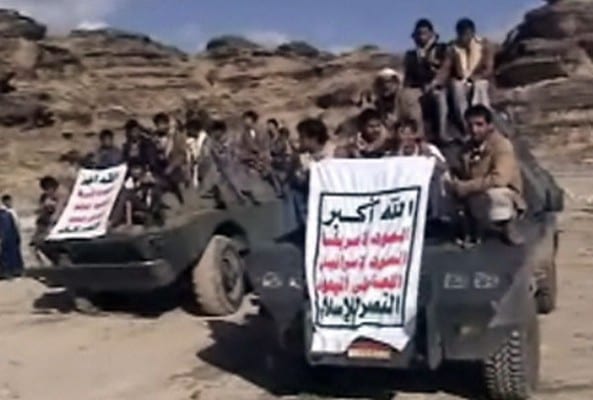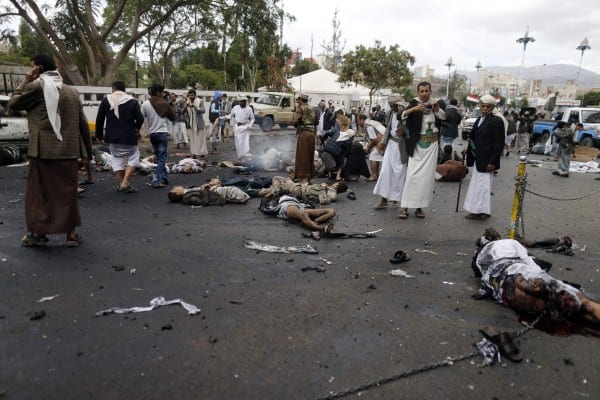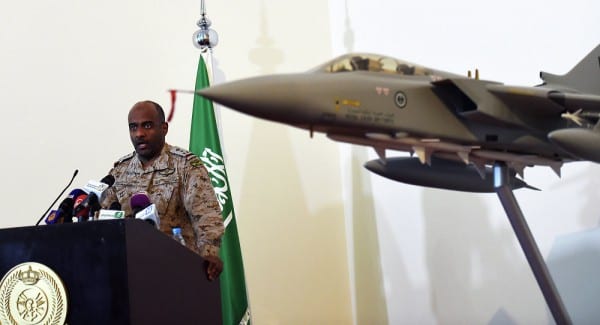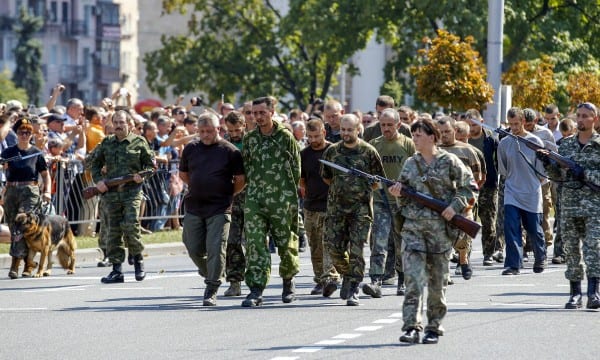The War Nerd: A Brief History Of The Yemen Clusterf*ck
“[Today we deal with fanatics and reactionaries throughout the Middle East]…because the modernizing Arabs were all killed by the US, Britain, Israel, and the Saudis.”
DILI, EAST TIMOR —
[dropcap]I[/dropcap] ought to be familiar with the Houthi, the Shia militia that’s now conquering most of what’s worth taking in Yemen. After all, the Houthis started in Saada Province, just a few miles due south of Najran, Saudi Arabia, where I was living a few years ago.
But the truth is Yemen was totally closed off to everyone in Najran, and no one except a few networks of smugglers and spies who, from what I heard, had a very high attrition rate, dared to cross that border. None of us expat goofs even knew the name of the Yemeni Province across from us. Yemen was that country from whose bournes no traveler returns, unless he’s hoping to get rich from an SUV full of weed—and what with the, you know, beheadings for drug dealing and all, we were pretty much a straight-edge crew in our time there, figuring to make up for lost time when we got home. We knew nothing about what was over the border except that every day there seemed to be a new convoy of car-carriers loaded with brand-new Land Cruisers with the logo of the Saudi Border Patrol rolling into town. The Saudi authorities were clearly nervous about that border, even back in 2011.
There was no road connecting Najran to Yemen. Instead there was a sheer, mile-high mountain wall that marked the Yemen border. The only Yemenis you met were beggars in the streets. One of them rolled up to me while I was waiting for the school van, said in English, as if we’d been chatting for ages, “My friend, eight years I Yemen…and so, you give ten riyals.” I gave him 20. In his spiel, “Yemen” summed it up, verb and noun, sufficient reason for his demand.
The only place I ever saw Yemenis who weren’t begging was the Najran Dam, the world’s most ridiculous tourist attraction. That Dam kind of sums up relations between Yemen and Saudi in a very cinematic way. You approach the dam up a canyon, through a checkpoint. They’re looking for Yemenis at the checkpoint; they wave you through, and after being stopped a few more times by nervous paramilitaries in Land Cruisers, who also check for Yemeni faces and wave, you reach the top of this huge, magnificent dam.
You walk across the little road over the top, expecting to look out on something like Lake Powell in Vegas, and see…nothing. Desert. Yemen. There’s no water except a tiny creek. There are boats marooned halfway up the rocky hillsides, but there’s no water, nobody can remember when there ever was water, and nobody expects there ever will be any water.
It’s still a tourist attraction, though, and one of the reasons is that you can see into Yemen. On one memorable occasion, we actually saw something much rarer: Yemenis, visiting Saudi with permission.
We didn’t notice them at first. We did our usual stroll across the top of the dam to the little picnic ground, where in theory you could sit, though you wouldn’t want to—and there was a huge family there. Not Saudis, but not South Asian or Western either. They didn’t look like anyone we’d seen. They were in a defensive circle, sitting on the grass. The men were on the outside of the circle, protecting the women. The women were in black, but not a Saudi-abaya black. They were thinner, shorter than Saudis, more alert—much more alert. And every single one of them was looking at us with an intensity you’d never see on a Saudi face.
We had no idea why they were staring at us like that, as if we were great white sharks instead of a gaggle of miserable TESOL mercenaries. Our van driver nodded towards them, said, “Yemen.”
There was never anything about Yemen in the Saudi press. Lots about “infiltrators” and “smugglers,” who were understood to be Yemeni, but nothing about what was actually going on on the other side of that mountain wall. Yemen equals trouble; that was the Saudi view, and all you ever got.
From this report in Al Akbar, it sounds like not much has changed since we left Najran. The Saudi authorities are still spreading hate against the Shia of the Southwest, and no one actually knows much about what’s going on south of the border:
“stories…tell of criminal activity by foreigners sneaking through the Yemeni borders, harassing and attacking homes along the Assir mountain range.
“The people of the south know very little about Yemeni politics and do not really understand the Saudi political approach toward Yemen. All they know is that a threat has emerged in Yemen.”
The Houthi are being bombed now by the Saudi AF, which is in a way the sincerest form of Saudi flattery. The Saudis are afraid of these Shia Yemeni. One of the reasons that “…people of the [Saudi] South know very little about Yemeni politics” is that the Saudi rulers make sure they don’t get any information. The last thing the Saudi authorities want is for the Shia of SW Saudi Arabia to remember that they were once part of a huge, powerful Shia kingdom that stretched south to the Indian Ocean. Najran was once part of that kingdom. It’s only been Saudi territory since 1934, when the Saud family leased the province from Yemen on a 20-year term. They kept it when the term expired, because by that time Saudi Arabia was rich and closely allied with the US and Britain, while Yemen was weak and poor.
The Saudis, with sleazy friends in Langley and unlimited cash to throw around, have incredible control over world media. They do such a good job of suppressing news about their long war with the Shia of Yemen that, until I lived there and got the story first hand, I didn’t even know that the Shia of Najran had actually risen up in armed rebellion in 2000. And it was an incredible story of a glorious, though doomed, rebellion.
In 2000, the Shia of Najran got sick of being told by their Saudi Provincial Governor (a Saudi princeling, naturally) that they were rafidii (“nay-sayers”) and takfiri (“apostates”). The Najrani grabbed their guns, scared off the Saudi national police and drove Prince Mishaal into hiding in the Najran Holiday Inn. You can still see the Holiday Inn; it’s as good as a Gettysburg monument to the locals, though the bullet holes have, unfortunately, been covered over.
That unknown rebellion ended with massive Saudi secret-police reprisals—more holes in the desert than a Joe Pesci golf tour. Once they’d killed off the ringleaders, the Saudi authorities went back to slower, less bloody methods. As I explained in 2012, they planned to neutralize the Shia threat in the southwest by buying the region a new demographic profile:
“Twelve years [After the Najran revolt of 2000], the Sauds are winning in a slower, smarter way. The locals have no friends, no money; their religion is slowly being Wahhabized, just like Islam in Indonesia and all the other places the Sauds are doing their best to make a little meaner and more rule-crazy in their own image. They’re doing it with demographics now, importing Sunni settlers from Yemen to tip the balance. There are rumors of a huge new city going up in the desert near the town I worked in, supposedly a ‘campus’ for the local university, but it’s twenty times bigger than that would ever need to be. It’ll be a Sunni city, a Wahhabi city.
“Meanwhile the local Ismaili Shi’ites try to stay alive and maybe even get a tiny piece of the tsunami of money that’s flowing over the rest of the country. They get very, very little of it, and most of what comes to the province goes for mosques—Wahhabi mosques, naturally. But they fought back when their beliefs were directly insulted, and to them, that still means a lot. In the meantime, they do what people in their position always do: they grovel when they have to, fight when there’s no choice, and have a lot of kids.”
Yeah, but that was in 2012, when the Saudis thought they had a lid on this thing. It’s all changed now, thanks to the Houthi victory in Yemen.
And it all began just a few miles south of that dam—in Saada Province, home of Hussein al Houthi, founder and martyr of the “eponymous” movement. (When did it become socially acceptable to use the word “eponymous”? I feel dirty.)
[dropcap]H[/dropcap]outhi was of the Fiver Shia sect called Zaydi, theologically moderate but fierce when committed to war. The Southwestern wedge of the Arabian Peninsula has always been largely Shia. The east, which spreads northeast toward Oman like a sun-baked brick, is almost uninhabited inland toward the Saudi border, but what population there is is Sunni, and chronically in conflict with the Shia wedge to the west.
Al Qaeda in the Arabian Peninsula (AQAP) is powerful there, helped and betrayed by turns by the Saudi security police, trying to hide from the American drones that occasionally drop a Hellfire missile on any AQAP pickup truck they can identify on the road.
The Shia have always been stronger and more numerous than the Sunni Yemenis in the east, but the last century wasn’t a good one for them. The Saudis, who were once “the ignorant Arabs,” got the oil, and Yemen got smaller and poorer.
Saudi Shia are barely tolerated, and consistently ignored by the Saudi media. The only way I found out that Najran was a Shia city was that none of my students showed up one day. Empty classrooms. I asked a colleague who looked around very carefully, then whispered, “Ashura.” Ashura is not mentioned in Saudi Arabia. They’re religious fascists and not shy about it.
And that’s what led to the forgotten rebellion in Najran, which was part of the long, slow struggle between the Shia of Yemen (Greater Yemen, which used to include Najran and everything up to Abha) and the other power in the Peninsula, the Wahhabi of the Najd.
The Saudis’ strength comes from three provinces , Al Qassim, Ha’il, and Riyadh—that make up the Najd, the uplands, the turtle-back of the Arabian Peninsula. What’s happening now, as Saudi planes bomb Houthi bases, is the latest of a long, chronic war between the Najd and Yemen.
Oil made the Najd strong in the 20th century, but even before it was discovered, Yemen was weakened by invasions, first the Ottomans and then the British. The Sunni of the Najd were lucky enough to be ignored—what did they have that was worth taking, before the oil was found?—whereas the Yemeni had two very valuable, stealable assets: coffee, and ports along the Red Sea and Indian Ocean.
There was a time when Yemen was the world’s only coffee exporter (Mocha is a town in Yemen, on the Red Sea) and though coffee was banned as a dangerous drug by Murad IV, he couldn’t make that Prohibition work, because the Turks were addicts from their first sip. They needed that caffeine buzz to help them look over maps and think about new provinces to conquer. And when they looked at Yemen, they saw a 2,000 km long coastline that could be dotted with Ottoman naval outposts, and they drooled—probably drooled coffee grounds all over the map. They wanted the coast. That was them all over; show them a landscape painting and they were calculating how many Janissaries it’d take to conquer it, how many new taxes they could squeeze out of their kaffir subjects to raise a new army and seize whatever your hotel-room artwork showed.
And they didn’t mind casualties. You can rank armies by their aversion to KIA; the IDF clearly goes at the top (it’s their great, fatal har-har weakness), and the Soviets and Ottoman rank near the bottom for sensitivity to body bags coming home. The Pashas started ordering their unlucky Egyptian lieutenants to make grabs for Yemen in the early 1500s. They made the classic mistake in judging the odds of going into Yemen, thinking that because it was localized and anarchic that it must be weak. Early in the 16th century a half-smart Ottoman pasha made this “cakewalk” prediction:
“Yemen is a land with no lord, an empty province. It would be not only possible but easy to capture, and should it be captured, it would be master of the lands of India and send every year a great amount of gold and jewels to Constantinople.”
Wrong on all counts. In the first half of the 16th century, the Empire sent 80,000 troops to Yemen. Only 7,000 of them ever came home.
The Ottomans had their own 16th-century version of the US Army’s “lessons learned” ritual after a failure, and their review of this debacle was brutal:
“We have seen no foundry like Yemen for our soldiers. Each time we have sent an expeditionary force there, it has melted away like salt dissolved in water.”
Army prose was a little more literary back then.
The Ottomans kept trying, sending one doomed army out from Egypt after another. They always were a land-hungry, over-extended empire, jerking off to maps rather than consolidating what really mattered.
Yemen wasn’t nearly as easy to take as it must’ve looked to the Ottoman policy-pasha wonks looking over a map of the Peninsula in Constantinople.
By 1634, the last Ottoman forces were permitted—“permitted,” you’ll note—to leave Mocha, the Yemeni coffee-packing port they’d coveted for almost a century. The Shia of Yemen, who seemed so leaderless and weak, had defeated them completely, though the endless wars with the Turks had also weakened the Yemenis.
What the Turks never got was that the Shia highlands of Yemen weren’t a “land with no lord,” but a land with a hereditary Imamate, a theocratic military leader like Hassan Nasrullah of Hezbollah. Nasrullah is a perfect modern Imam, a sectarian icon, which may be why he looks like Gerry Adams after six months on an all-donut diet. Moqtada al Sadr in Iraq has a similar role.
An Imam isn’t supposed to interfere too much in clan business in normal times. His most important job is to unite the sect when it’s under threat. The Imam is a mobilizer above all, which the US found out the hard way when they messed with Moqtada in Baghdad.
When the Shia of northern Yemen mobilize, like they have now, they always move outward from their stronghold in Saaba Province in the same directions: either North toward Najran and Abha, or West to the Red Sea (Jizan), or South to Aden.
As long as they stick together under a strong Imam, they’re hard to beat. But after the Turks left in the mid-17th century, the Yemenis faced a much smarter empire: the British. Very few countries held off that Empire for long. Between the Americans’ victory in 1783 and Irish independence in 1922, not one country was able to eject the Empire. Tens of millions died trying — brave, brilliant empires like the Sikhs and the Zulus; no one succeeded. We forget that now, because . . . well, you know that amnesia flash device from Men in Black? It was actually the British Empire that invented that thing, and asked the world to smile and say cheese when it decided to dissolve itself around 1960. And like Tommy Lee Jones in that movie, their last act was to use the flash on themselves, so they could say in all truth, “Empire? What Empire?”
[dropcap]B[/dropcap]ut in 1840, at their peak, the British were beautiful to watch. They were masters at handling a complicated, clannish country like Yemen. They never made the mistake of rolling in and claiming the whole place as the Turks had. That only united the locals. Instead, they did what they were good at: using proxies, fomenting divisions, creating distractions—the original force multipliers. And even when they lost battles or campaigns, they left their enemies weakened, often for good.
In 1840, they realized they could use Aden as a coaling port for the fleets that kept their Indian operation, the big money-maker, in business. And that was that; they needed Yemen, and they were going to get it. They landed at Mocha almost exactly two centuries after the Turks evacuated it.
The British used another Imperial strategy now forgotten: forced immigration by subject peoples. Aden, the focus of their ambitions in Yemen, became a “world town” in the 19th century, with about a thousand Arabs swamped by South Asian, SE Asian, and African immigrants. Those were the perfect inhabitants, with no links to the locals and entirely dependent on the Empire’s protection to avoid being killed by the angry Yemenis.
Aden stayed fairly quiet, in Yemeni terms, until the 1960s, when Britain, Egypt, and Saudi Arabia fought a dirty, complicated Yemeni war. Aden blew up, with grenade attacks on British officials, who had a witty riposte in the form of torture centers that pioneered many of the techniques you’ll remember from Abu Ghraib, with emphasis on sexual degradation and nakedness.
The British got called on these torture centers—they were a little sloppy, not in form, during the 1960s—and left in 1967. The real action moved up north to Houthi territory, where Nasser, hope of the Arab world in the 1960s, decided that a modern, Arab-nationalist regime in Yemen would be a big move for him, Egypt, and the Arabs.
Arabs were getting very “modern” at that time. It’s important to remember that. You know why they stopped getting modern, and started getting interested in reactionary, Islamist repression?
Because the modernizing Arabs were all killed by the US, Britain, Israel, and the Saudis.
That was what happened in the North Yemen Civil War, from 1962-1967. After a coup, Nasser backed modernist Yemeni officers against the new Shia ruler. The Saudis might not have liked Shia, but they hated secularist, modernizing nationalists much more. At least the Northern Shia kings ruled by divine right and invoked Allah after their heretical fashion. That was much better, to the Saudi view, than a secular Yemen.
And the west agreed. To the Americans of that time, “secular” sounded a little bit commie. To the British, it sounded anti-colonial and unprofitable. To the Israelis, it raised the horrible specter of an Arab world ruled by effective 20th-century executives. States like that might become dangerous enemies, while an Arab world stuck in religious wars, dynastic feuds, and poverty sounded wonderful.
Why do you think the IDF has not attacked Islamic State or Jabhat Al Nusra even once? (Or said anything, let alone attack the Ukrainian Nazis?—Eds)
So all the factions we call “The West” jumped in to destroy these Yemeni officers: British commandos and pilots, Israeli military advisors, CIA bagmen, NSA geeks, and mercenaries from all over the world.
That was the all-star lineup fighting “for Allah and the Emir,” as the idiots at Time Magazine enthused in a 1963 article.
And of course that lineup won easily, against a clique of officers and a half-trained Egyptian expeditionary force. Egypt lost something like 25,000 soldiers in Yemen; you don’t fight a British/Saudi/American/Israeli/Islamist/Royalist coalition like the one they were facing without losing big. After the Six-Day War in 1967, when it lost the Sinai, Egypt had no interest in bothering about Yemen and called its surviving troops home.
If you look at a control map of Northern Yemen in 1967, when the war ended with Egypt’s total defeat, you see that the Egyptian forces and their Yemeni allies still controlled some of the southern areas around Taiz (which was just taken by the Houthi last week), while the Royalists, the conservatives, controlled all of Saada Province and the north, the areas across from Najran.
So the Houthi, whose core strength perfectly maps the Royalists’ areas of control in 1967, draw their strength from these same conservative areas. As for the modernist, secular Yemenis, they’re just gone. Emigrated, or died, or saw their children seduced by the madrassi.
That scenario was repeated all over the Middle East during the Cold War, and it has a lot to do with how messed up the place is now. “For Allah and the Emir”; when Time ran that headline in 1963, that slogan sounded quaint and kind of touching. . . . It sounded like a nice alternative to Nasser, nationalism (and its much more dangerous corollary, nationalization) or, worse yet, Communism.
So the West put its weapons and its money in on the side of “Allah and the Emir” over and over again, against every single faction trying to make a modern, secular Arab world, whether on the Nasserite, Ba’athist, Socialist, Communist, or other model.
It worked very well . . . or badly, if you prefer. It left Yemen festering, like most of the Arab world, with a weak royalist regime in the north and an even weaker socialist state in Aden. In 1990, after the collapse of the USSR, that southern Yemen state dissolved, taking the last of its fading “socialist” posters and slogans with it. Yemen was reunited, in theory; a poor, sectarian, anti-modern nightmare state.
By that time, “For Allah and the Emir” was pretty much the only slogan anywhere in the Arab countries. It had gone from quaint and quirky to universal. The only option left was to choose which version of Allah, and which corresponding emir, you were going to back.
The Houthi are as conservative and devout as the Saudis who are using every plane they’ve got to bomb them at the moment.
In fact, their favorite poster is a devoutly blood-thirsty souvenir of Tehran in the Khomeini years:
God is great.
Death to America.
Death to Israel.
A curse upon the Jews.
Victory to Islam.
Of course, the Houthi, as Shia, worship the wrong version of Allah, from the Saudi perspective. But that didn’t bother the Saudis, or the Americans, or the British, or the Israelis, back in the 1960s when they all joined hands (in a very non-peace-and-love way) to wipe out the modernizing Yemeni.
Arabs are reduced to choosing which Allah and which Emir to support because a half-century alliance between the worst oligarchies in the West and the most reactionary elements in their countries wiped out the alternative. That’s why it’s so grotesque to hear right-wingers blaming the Arabs for the lack of commitment to democracy and even more ridiculous that Leftists demand respect for fascist thugs like Islamic State, as if they were the voice of the Muslim people.
These sectarian wars are what’s left when you’ve killed everybody else who was attempting to provide Arabs with an effective, secular, modern existence.
Gary Brecher is the War Nerd.
[printfriendly]
What is $5 a month to support one of the greatest publications on the Left?















